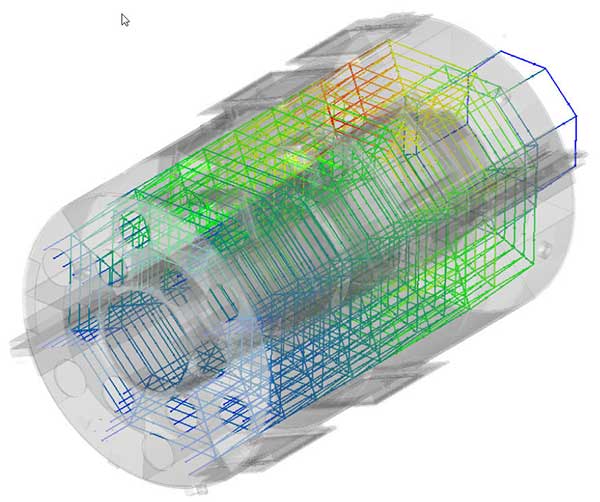
CAD-integrated 3D flow network model designed in Flow Simulator to solve challenging thermal management problem of an aerospace engine under cowl. Image courtesy of Altair/GE Aviation.
Latest News
February 25, 2021
Altair has acquired Flow Simulator from GE Aviation. Flow Simulator is an integrated flow, heat transfer and combustion design software, which enables mixed fidelity simulations to optimize machine and systems design.
As part of the acquisition, Altair and GE Aviation have signed a memo of understanding (MOU) to facilitate a higher level of collaboration and establish a long-term strategic partnership. The relationship will include Altair's continuous development of Flow Simulator; granting GE Aviation access to Altair's complete software suite to explore enhanced functionality aligned to real-world use cases and workflows; and ongoing executive engagement between both parties to establish deeper strategic alignment and pursue new ventures.
“We successfully collaborated with GE Aviation for many years on several initiatives including rotor dynamics using Altair OptiStruct, which opened doors for new opportunities to work together. We value our strong relationship with GE Aviation as we join forces to drive innovation for aircraft engines and beyond,” says James R. Scapa, founder and chief executive officer, Altair. “Utilizing Altair's simulation and AI-driven approach to innovation, there is great potential to expand Flow Simulator's capabilities and make it available to new industries focused on simulating systems models including automotive, electromobility, battery, defense, and renewable energy.”
“Altair will bring Flow Simulator's capability to simplify the modeling of complex thermal systems to new industries. This will expand global technical capabilities,” explains Arjan Hegeman, senior executive–Technology, GE Aviation. “Concurrently, GE Aviation and Altair will continue developing Flow Simulator together, with even more advanced simulation technologies and design tools that will continue to expand its capabilities for a broader base of users.”
System-level design has become increasingly critical as organizations are tasked with simulating complex duty cycles. Fast software solutions like Flow Simulator are needed to model an entire system, including rapid iteration concept modeling and understanding of system simulation and system behavior in applications such as rotating machinery design, electromobility, wind turbines, heat exchangers and virtually anything that encompasses thermal management.
GE Aviation developed Flow Simulator to serve as a fast flow network simulator for aircraft engines–simulating how an entire flight cycle would behave in the real world, from runway and take off to flight and landing. Since its inception, it has been used to simplify modeling for various complex thermal systems applications, including healthcare, locomotives and renewable energy. Prior to acquiring the technology, Altair was a commercial distributor of Flow Simulator, which was available through the Altair Partner Alliance (APA).
Key Features:
- Fully-coupled flow/thermal network modeling–An extended library of preconfigured elements and components leveraging a large set of publicly-available experimental data for pressure drop and heat transfer characteristics.
- Control system module–Proportional integral derivative (PID) controllers, feedforward, and missions can be integrated with flow/heat transfer models to optimize the simulated-machine operation during cycle/mission analysis.
- Optimization module–Monte Carlo, Optimal Latin Hypercube and N-factorial analyses quickly explore the entire design space of a 3D modeling environment. An analytical model can be parametrized based on flow configuration, shape, dimension and thermal characteristics to achieve an optimal cost-benefit design.
- User-defined elements–Ability to integrate a customer's own IP and element formulations using UDE creator supported in flexible python scripting as well as with Fortran language. APIs are provided an option to connect Flow Simulator with external software for multidisciplinary analyses.
- Intuitive interface–A modern interface for pre, post, solve and optimization. The three-dimensional design environment gives users the ability to overlay/integrate the network model with 3D computer-aided design (CAD) while integrating a customer's IP and element formulations seamlessly.
For more information about Flow Simulator, click here.
Sources: Press materials received from the company and additional information gleaned from the company’s website.
More Altair Coverage
Subscribe to our FREE magazine, FREE email newsletters or both!
Latest News
About the Author
DE’s editors contribute news and new product announcements to Digital Engineering.
Press releases may be sent to them via DE-Editors@digitaleng.news.






